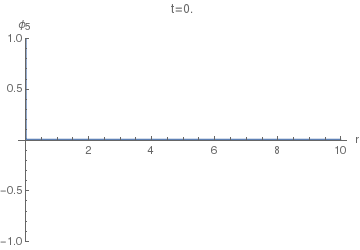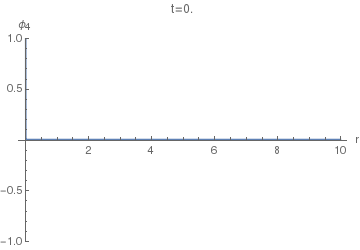What does a 4+1D wave look like at the light cone?
Physics Asked on July 11, 2021
I need help making sense of a few comments from under this answer. I think it’s best if I reproduce the comments below:
-
“The Green’s function for the wave equation in even spatial dimensions is positive-definite inside the light cone, so you can’t get destructive interference”.
-
“The Green’s function for the (4+1)? wave equation is indeed sign-definite strictly inside the light cone, but it has a delta-function of the opposite sign exactly on the light cone. See eq. (36) from this source”.
-
“As improbable as it sounds, I suspect that when dimensionally reducing from (4+1)? to (3+1)? space, there’s a magical conspiracy such that after the initial positive wavefront passes, its infinite-duration negative wake is continuously exactly canceled by successive positive wavefronts arriving from sources that are ever further-away in the fourth spatial dimension”.
My questions are more related to the second comment. What does it mean that the Green’s function for the 4+1D wave equation has an opposite sign delta-function exactly on the light cone?
What would the wave look like at that location (the light cone)?
Shouldn’t there be other positive terms at the same location (the light cone) to balance the negative term mentioned in the comments (the opposite sign delta-function)?
I’m hoping to visualize how the wave would look like at that location, so I’m looking for more of a conceptual answer, without much math.
2 Answers
For ease of reference in this post equations are numbered as in ref. 1.
The equation $(36)$ cited in the OP reads
$$G_4(r,t)=frac1{4pi^2c^3}left(frac{delta(t-r/c)}{r(t^2-r^2/c^2)^{1/2}}-frac{eta(t-r/c)}{c(t^2-r^2/c^2)^{3/2}}right).tag{36}$$
Here $delta$ is the Dirac delta, and $eta$ is the Heaviside step function.
By itself, this expression doesn't really help understand what's going on: the Dirac delta in the first term is multiplied by a function that is singular at the delta's distributional singularity, and the second term isn't integrable. So, even if there is some way to evaluate this Green's function as a distribution like $langle G_4,hrangle$ for a smooth test function $h$, I suppose the expression would have to be transformed somehow.
Let's go another way. Namely, start from how equation $(36)$ was derived. The authors in ref. 1 derived it by integrating the Green's function for (5+1)-dimensional wave equation,
$$G_5=frac1{8pi^2c^2}left(frac{delta(tau)}{r^3}+frac{delta'(tau)}{cr^2}right),tag{32}$$
where $tau=t-r/c$, along the line of uniformly distributed sources in 5-dimensional space, using the integral
$$G_{n-1}(r,t)=2int_r^infty s(s^2-r^2)^{-1/2}G_n(s,t)ds,tag{25}$$
where $r=r_{n-1}$ is the radial coordinate in $(n-1)$-dimensional space.
Remember that a Green's function for a wave equation is the impulse response of the equation, i.e. the wave that appears after the action of the unit impulse of infinitesimal size and duration, $f(r,t)=delta(r)delta(t)$. For visualization purposes it's useful to replace this impulse with one that is finite at least in one variable, e.g. time. So let's choose another force function $f(r,t)=delta(r)F(t)$, where $F$ is defined as the Gaussian function
$$F(t)=frac1{sqrt{2pi}sigma}expleft(-frac{x^2}{2sigma^2}right).$$
Then, following equation $(34)$, we'll have the displacement response of the (5+1)-dimensional equation given by
$$phi_5(r,t)=frac1{8pi^2c^2}left(frac{F(tau)}{r^3}+frac{F'(tau)}{cr^2}right).tag{34}$$
Now, to find the displacement response $phi_4(r,t)$ of the (4+1)-dimensional equation, we can use $phi_5$ instead of $G_5$ in $(25)$. The resulting integral doesn't seem to have a closed form, so the following animations of $phi_4(r,t)$ were done using numeric quadrature.
In the animations below we use $c=1$.
Let's first see how the $phi_5(r,t)$ looks. This will enable us to compare it with $phi_4(r,t)$. The following animation uses $sigma=0.005.$
We can see that it basically has two spikes: one positive and one negative. Let's increase $sigma$ to $sigma=0.04$ to resolve them better:
Now we can finally look at $phi_4(r,t)$. The following animation uses $sigma=0.005$, as the first one above.
Notice the difference of this wave from the $phi_5(r,t)$: the former has a "tail" inside the light cone, i.e. on the LHS of the positive spike here. This tail corresponds (in the limit $sigmato0$) to the second, negative, term in the equation $(36)$, while the positive spike corresponds to the first term with the Dirac delta.
So, the answer to
What does it mean that the Green’s function for the 4+1D wave equation has an opposite sign delta-function exactly on the light cone?
is exactly that: there is a negative wake inside the light cone and the opposite sign, i.e. positive, Dirac delta, i.e. infinitely high and narrow spike, on the light cone.
References:
1: H. Soodak, M. S. Tiersten, Wakes and waves in N dimensions, Am. J. Phys. 61, 395 (1993)
Correct answer by Ruslan on July 11, 2021
It should be stressed that the retarded Green's function (36) in Ref. 1 is not mathematically well-defined. It contains a singular function times a distribution, which is not well-defined in distribution theory.
In my Math.SE answer here I instead defined it via analytic continuation/Wick rotation of the Euclidean Green's function, and provide various explicit formulas. It should be straightforward to implement numerically. Moreover this regularization scheme keeps a version the inter-dimensional recurrence relations (25) and (29) in Ref. 1. Recall in particular that eq. (25) is responsible for the "magical conspiracy" mentioned in OP's 3rd point. And the recurrence relations guarantee that the Huygens' principle works in odd spatial dimensions.
The (ill-defined) Dirac delta distribution "of the opposite sign exactly on the light-cone", as OP writes, is a coincidence in 4+1D. It e.g. doesn't appear in 2+1D, cf. eq. (35) in Ref. 1. And in higher even spatial dimensions (i.e. in the dimensions where Huygens' principle doesn't apply), it depends on derivatives of the Dirac delta distribution, and so forth.
References:
- H. Soodak & M.S. Tiersten, Wakes and waves in $N$ dimensions, Am. J. Phys. 61 (1993) 395.
Answered by Qmechanic on July 11, 2021
Add your own answers!
Ask a Question
Get help from others!
Recent Questions
- How can I transform graph image into a tikzpicture LaTeX code?
- How Do I Get The Ifruit App Off Of Gta 5 / Grand Theft Auto 5
- Iv’e designed a space elevator using a series of lasers. do you know anybody i could submit the designs too that could manufacture the concept and put it to use
- Need help finding a book. Female OP protagonist, magic
- Why is the WWF pending games (“Your turn”) area replaced w/ a column of “Bonus & Reward”gift boxes?
Recent Answers
- Joshua Engel on Why fry rice before boiling?
- haakon.io on Why fry rice before boiling?
- Lex on Does Google Analytics track 404 page responses as valid page views?
- Jon Church on Why fry rice before boiling?
- Peter Machado on Why fry rice before boiling?


